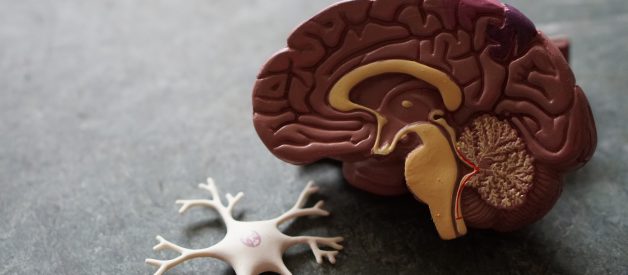How does your brain process information and store them as memories?
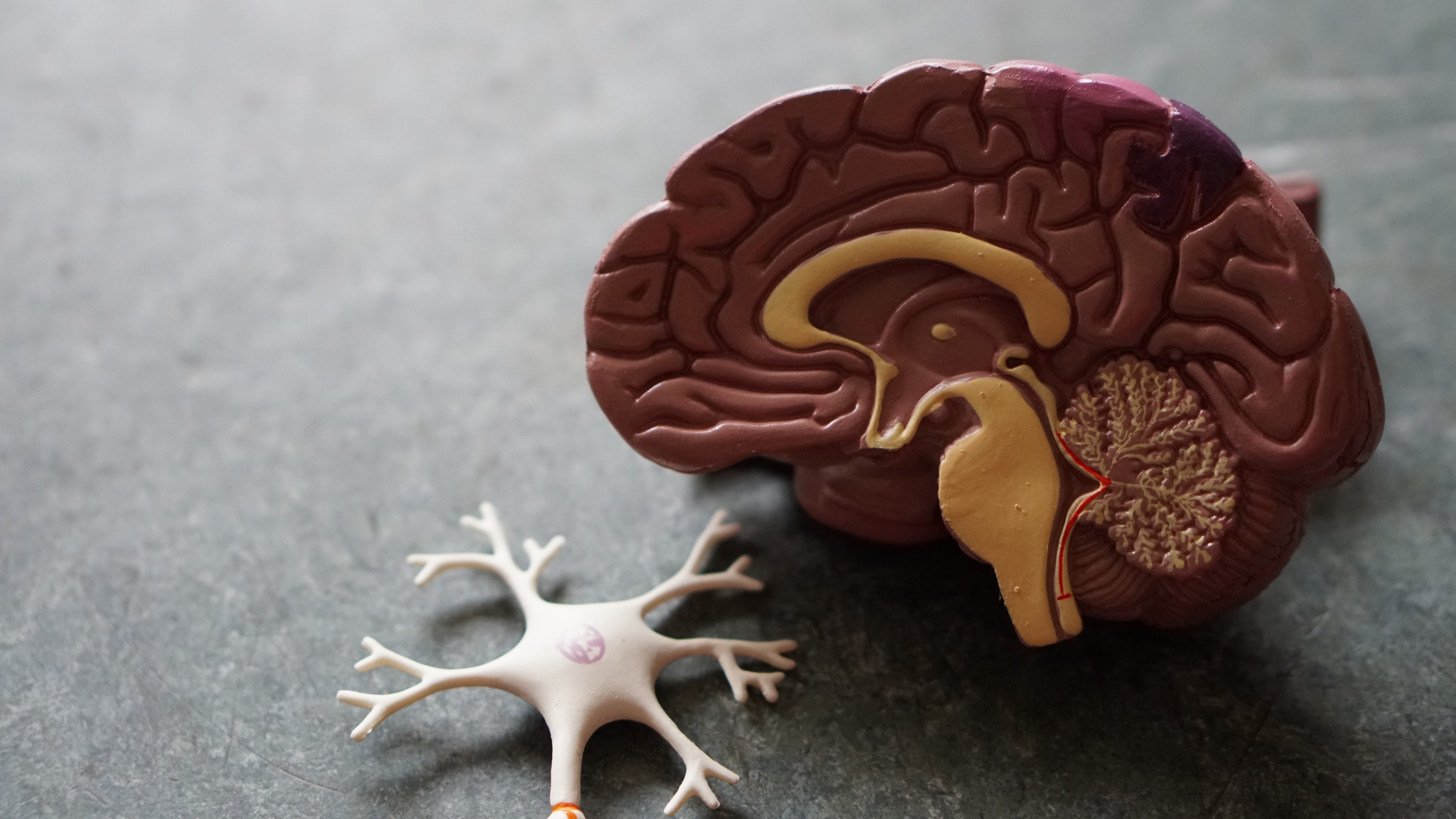 Photo by Robina Weermeijer on Unsplash
Photo by Robina Weermeijer on Unsplash
Most of us take our memories for granted. We as human beings remember our past and imagine future scenarios as the only animal that we know.
But what are memories? How are they stored in our biological cells and neural network? What does it even mean to store them? Does the chemistry in the cells change? Do the neurons get more or better connections? What does it even mean?
It?s hard enough to imagine an image or a video as stored in 1?s and 0?s in a computer, but it?s not even like we can store vivid memories or imaginations in bits and bytes and retrieve and distribute a perfect copy. Wouldn?t that be nice, though?
Our human memory is quite impressive, but on the other hand also quite flawed. Did you know, that every time you retrieve a memory of an event, it will become more flawed and less correct?
When you retrieve a memory it gets influenced by newer thoughts, emotions, and knowledge which can interfere with the memory structure of the neuron connections, so when it is saved again in the long-term memory after being retrieved, it might no longer be the same as before. It becomes a memory of a memory. You will not be able to know the difference since it?s not like you have version control of memories. You cannot check with a backup.
Let?s look at the details of how different kinds of memories are stored and handled in the brain.
The grey matter a.k.a. the cerebral cortex
Let?s first take a look at the brain as a whole. The brain consists of a lot of fat tissue (60%), different types of brain cells (neurons) and arteries that lead blood up to the brain.
 Grey matter is the outer part of the brain and contains the cell body of the neurons. White matter is the inner part of the brain and contains the cell axions, where messages are passed on from the neuron cell body. Credits: AboutKidsHealth.ca
Grey matter is the outer part of the brain and contains the cell body of the neurons. White matter is the inner part of the brain and contains the cell axions, where messages are passed on from the neuron cell body. Credits: AboutKidsHealth.ca
The outer brain surface is called the grey matter of the brain and also referred to as the cerebral cortex. We have grey matter and white matter in the brain.
Neurons have their receiving cell body in the grey matter and their long axions, where messages are passed on to other neurons, in the white matter ? the inner part of the brain.
The cerebral cortex (grey matter) has different areas with different functions. Take a look at the image below.
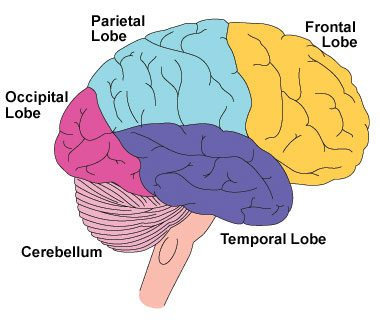 The four main areas of the cerebral cortex. Credits: Wikipedia Commons.
The four main areas of the cerebral cortex. Credits: Wikipedia Commons.
We talk about four main cerebral cortex lobes of the brain.
- Frontal lobe: Our latest developed part of the human brain and also the largest part of the cerebral cortex. This part is responsible for our cognitive functions, emotional expressions, abstract thinking, our spoken language, planning, executive functions, our self-image (ego) and even most likely our consciousness.
- Parietal lobe: This part processes the sensory information it receives from all over the body.
- Occipital lobe: Responsible for visual processing.
- Temporal lobe: Sound and the auditory language is processed here.
All the lobes exist in pairs. As you might know, there is a left hemisphere and a right hemisphere of the brain.
The last part of the brain un the above image, the cerebellum, is a part of the brain that we have in common with all verberates. Motor functions are processed in this part of the brain. Cerebellum means ?little brain? in Latin.
The memory storing process
Memories are made in a complex system where there is more than one type of memory.
First, we experience something with our senses. We see, hear, smell, taste or touch something. We know of three types of sensory memories that are used to retain impressions of sensory information after the original stimulus has ceased: The iconic (visual), the echoic (hearing) and the haptic (tactile) memory. This is why you will see traces of fast-moving light in the darkness. The sensory memory retains a short ?snapshot? of the stimuli for a few seconds and is not a conscious choice.
 The process of memory storing. Wikipedia Commons.
The process of memory storing. Wikipedia Commons.
When we give something attention, it is then temporarily saved into our short term memory. A lot of our sensory experience gets filtered out even before it reaches the short-term memory. If we didn?t have this filter, our brain would have been overstimulated with constant sounds, and visual and tactile impressions. We are not aware of most of these sensory inputs, because it?s not necessary for our functionality and our brain needs the processing power.
What comes into our short-term memory stays here for 15?30 seconds, if we don?t rehearse it. We can rehearse it in a rehearsal loop to keep it in our short-term memory for time. If we don?t rehearse it, practice or otherwise continue thinking about it, the impulses in the short term memory will be forgotten. What we repeat or continue thinking about for a longer time will be saved in long-term memory.
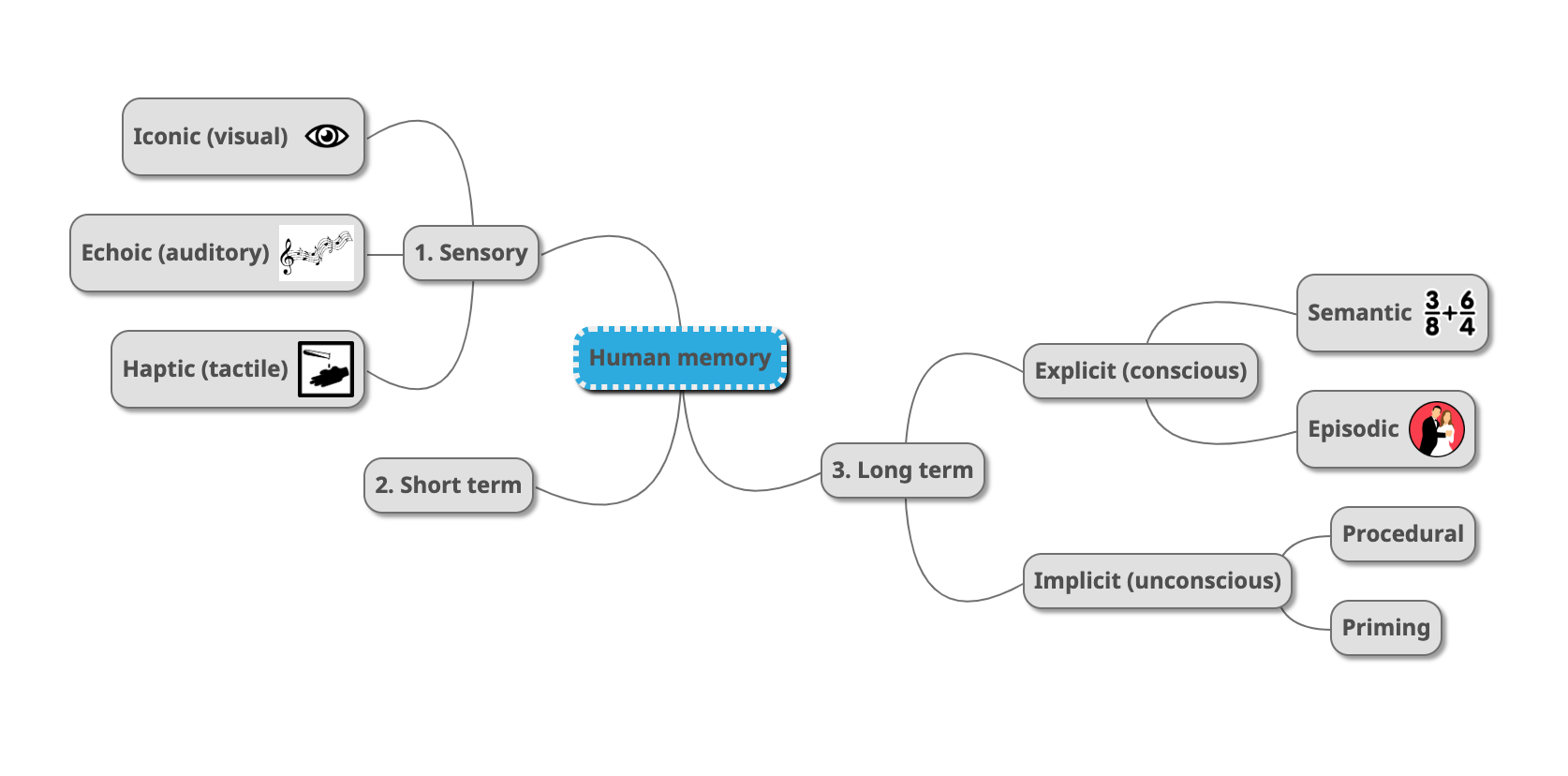 Mindmap of types of human memory. Own creation.
Mindmap of types of human memory. Own creation.
There are two types of long term memory: Explicit (conscious) and implicit (unconscious).
The explicit is what the memory that you are aware of and use or practice consciously. This can again be split into two kinds:
- The semantic, which are the factual long term memories, such as the order of the weekdays, an equation or the capital of Sweden.
- The episodic, which are more emotional and event-based long term memories, such as what happened on your 21st birthday or how you felt when you saw the twin towers collapse.
The episodic memories are what we mainly refer to as our long-term memories in this article.
The implicit is the things that you or your body remembers unconsciously, such as how to walk (procedural memory). In the implicit memory, we also have priming, which combines related memories to remember something faster, such as priming the word yellow, would make you answer banana faster than strawberry.
There are different types of priming, but it?s outside the scope of this article.
How and where are memories stored?
Throughout history, we have learned a lot about the brain from people with brain injuries or operated brains in different parts. Having injured or removed a brain part can affect different parts of your memory or your personality.
One known example is ?Patient HM?: Henry Molaison, who got a brain surgery in 1953, where part of his brain that caused epileptic seizures was removed. Unfortunately, that part of the brain that got removed, which was parts of the hippocampus and amygdala, also plays an important role in storing long-term, memories. After the operation, Henry was not able to store any new long-term memories, although he did still have the memories stored from before the operation.
Let?s get back to the brain and look at what we know about how memories are stored during the above process in the brain.
If we cut the brain in half, and look at it from inside, other important parts are revealed, shown in the image below.
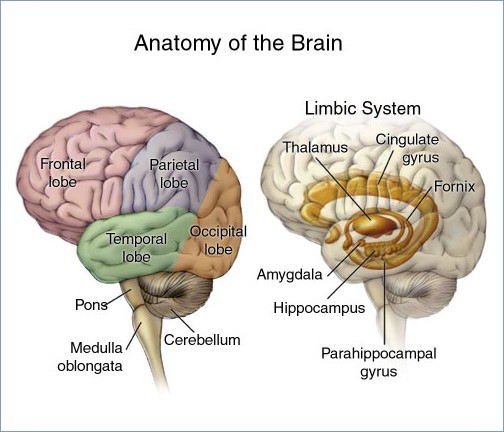 Another view of the cerebral cortex (grey matter) which is the surface of the brain and a look at the limbic system inside the brain. Credits: Wikipedia Commons.
Another view of the cerebral cortex (grey matter) which is the surface of the brain and a look at the limbic system inside the brain. Credits: Wikipedia Commons.
Hippocampus is placed inside the temporal lobe and is very important for our memory functions. It processes all information and chooses which memories should be stored for the long-term.
Amygdala, which is placed close to our hippocampus, is important to the processing of memory and responsible for emotional responses, such as fear, anxiety, and aggression. It also affects our decision making based on those emotions (?fight or flight? is an amygdala-thing).
The way the brain is physically mapped does also affect how things are remembered. Amygdala being so close to the hippocampus is the reason why we remember strong emotional events more clearly and longer.
From sensory input to short term memory
The physical experience of something can come from several sensory inputs. The neurons responsible for smelling are the only brain cells that physically reach outside your body. The olfactory neurons with odor receptors are places high inside your nose and connect directly to your brain.
 The olfactory neurons are bipolar neurons with one side of nerve ends in the nasal cavity and the other side connecting to the brain. Credits: Wikipedia Commons.
The olfactory neurons are bipolar neurons with one side of nerve ends in the nasal cavity and the other side connecting to the brain. Credits: Wikipedia Commons.
Smell is the only sensory information, that reaches the hippocampus directly without having been through other parts of the cortex. The close path between the olfactory neurons and the hippocampus might be one of the reasons why a certain smell might bring back a stored memory (the smell of Christmas).
All other sensory experiences are processed through different parts of the brain, before reaching the hippocampus.
Before an experience reached the hippocampus, it?s just a short term memory.
Form short term to long term memory
The short term memory is part of your working memory and can be compared with the RAM-disk of your computer. This handles whatever you are working on at the moment. You might be thinking of things you need to pick up at the grocery store. If you don?t write it down, you might have forgotten half of it later when you are at the store.
The hippocampus is essential for storing episodic memories for the long term. It takes information from different sensory regions of the brain and connects them into a single ?episode? of memory. The hippocampus is the reason why you don?t have separated memories of a smell, a look, a taste, a feel, and a sound, but one single integrated experience.
If your hippocampus got damaged, like in the case of patient HM, you would no longer be able to remember anything for more than a few minutes (and then only when repeating). Every experience that Henry would have after his operation would feel new to him, even though he had done something or met someone repeatedly after the operation. He could not imagine the future either. He was literally living in the present.
So, being able to store memories for the long term not only creates your memories it also gives you the ability to imagine a future. The hippocampus is what gives human beings the arrow (or illusion) of time and gives us the ability of mental time travel.
The hippocampus is what gives human beings the arrow (or illusion) of time and gives us the ability of mental time travel.
Memories stored long-term are stored in all parts of the brain. Once a memory is stored in the long-term memory, it is there, even though you destroy the part of the brain, that has to do with memory processing.
Your long term memory is like the hard drive on your computer. Those are the things you have saved for later.
Motor memory
Another thing we learned about the brain from patient HM, is that we have a motor memory. Our body can remember things, that our mind doesn?t. The patient with the damaged hippocampus, Henry, was asked to draw lines between points while looking at the pen and paper in the mirror. Every time he did not remember to ever have done this exercise before, but at the same time, he became better by practicing.
Unconsciously he remembered his movements, although he was not aware of the memory. Therefore these procedural long-term memories are not processed in the same parts of the brain. The long term motor skills are stored in the cerebellum ? the ?little brain? that we have in common with all vertebrates.
How are memories retrieved
So, different parts of the cerebral cortex are responsible for registering the sensory here and now experience and the hippocampus is responsible for connecting the information into one experience, and then the episodic memories are stored for the long term in different parts of the brain again.
How can we retrieve the memories again?
When you remember something, the same neural network that was used for creating the memory gets activated again. At the same time, your brain tells you that it is only a memory, which is lucky because otherwise, it would be like hallucinating and being back in your memory. Maybe that is what true time travel would be about?
As mentioned at the beginning of this post, our long-term episodic memory will become more flawed in time. Every time we retrieve a memory of an event, the neural network of the same neurons is activated. Then it gets influenced by your current communication between neurons.
Your retrieved memories get influenced by newer thoughts, emotions, and knowledge which can interfere with the memory structure of the neuron connections and give you false memories.
So, when a specific episodic memory is saved again after being retrieved, it might no longer be the same as before. It becomes a memory of a memory. The memory can become so altered, that we can end up having false memories without realizing it.
These false or biased memories are also partially due to the effectivity of the brain, to fill out holes in our memory by suggested patterns based on previous experiences. It makes the brain operate quicker and is helpful most of the time, but it also makes it prone to errors.
While both sides of the hippocampus seem to be involved in the episodic memory storing and retrieval, only the right side of the hippocampus is involved in the retrieving of semantic memories.
Both the episodic and the semantic memory retrieval seem to be crucial to our imagination and foreseeing of future scenarios.
Takeaways
The brain is quite a complex organ, that we still haven?t mapped completely. The whole brain is used for memories, but the hippocampus is especially important for storing various sensory information into one integrated memory saved for the long term.
The grey matter is the outer part of the brain and is often mapped in different areas with different functionalities. The cell bodies of the neurons are in the grey matter, while the nerve ends, axions, reach inside the inner white matter.
Inside the brain, we have the limbic system with the hippocampus and the amygdala, important for the long term processing of episodic memories and emotions. The right hippocampus is also responsible for storing semantic (factual) memories. Both types of memories are explicit (conscious).
The motor memory is processed in other parts of the brain and stored in the cerebellum. It is part of implicit memory, that lies outside your awareness. Priming, that might connect associated memories, is also part of the implicit memory.
Retrieving of episodic memories might get flawed over time, since every time we retrieve it and store it again, it might have been influenced by our current neuron activity. The brain might also fill out holes and create false memories.
Since the hippocampus is responsible for our ability to mentally time travel to the past (by remembering) and to the future (by imagining and foreseeing), the hippocampus might be called our personal time travel machine.
